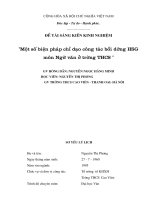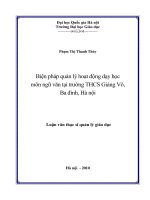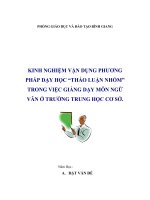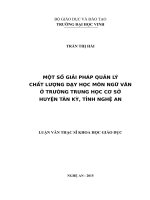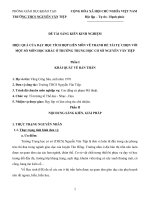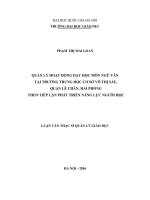MÔN ANH VĂN 9 - Trường Trung Học Cơ Sở Nguyễn Thiện Thuật
Bạn đang xem bản rút gọn của tài liệu. Xem và tải ngay bản đầy đủ của tài liệu tại đây (2.31 MB, 7 trang )
<span class='text_page_counter'>(1)</span><div class='page_container' data-page=1>
<b>UBND QUẬN CẨM LỆ</b>
<b>TRƯỜNG THCS NGUYỄN THIỆN THUẬT</b>
<b>NỘI DUNG BÀI HỌC MÔN TIẾNG ANH 9</b>
<b>TIẾT 01: HƯỚNG DẪN HỌC & ÔN TẬP</b>
<b>A. HƯỚNG DẪN HỌC.</b>
<b>I. Introducing the structure of an English book:</b>
1. Each book contains 6 units with 6 subjects.
- Unit 1: Local Environment
- Unit 2: City Life
- Unit 3: Teen Stress and Pressure
- Review 1
- Unit 4: Life in the past
- Unit 5: Wonders of Viet Nam
- Unit 6: Viet Nam: Then and Now
- Review 2
2. Each Unit goes or follows the steps: Getting started, A closer look 1, A closer look 2, Communication,
Skills 1, Skills 2 and Looking back & project.
<b>II. The way to prepare a lesson well at home:</b>
1. English is not too difficult but it requires your working hard.
2. Focusing on vocabulary you come across. Write sentences with the new words to understand more.
3. Review the lesson every day.
4. Practice English every day.
<b>B. ÔN TẬP.</b>
<b>1. Complete each sentence using the correct conjunction from the parenthesis. </b>
1. He’s overweight, ___________ he continues to eat lots of cakes and biscuits. (and, so, yet)
2. I’ve drunk six cups of coffee today, ___________ I’ve got a headache. (and, so, but)
3. The lesson finished, ___________ everyone went home. (and, or, but)
4. We’re making good progress, ___________ we’ve still got a long way to go. (but, so, or)
5. The climate is getting warmer. Maybe it’s natural, ______ maybe it’s caused by us. (and, but, or)
6. Maria didn’t do any revision, ___________she didn’t pass the exam. (but, so, or)
7. To get to Vancouver, you can fly, ___________ you can ride the ferry. (and, or, yet)
8. I’m afraid of heights, _________ I appreciate the view from the top of this building. (and, yet, so)
9. It isn’t in a very nice part of town, _________it’s a good restaurant. (but, and, so)
10. I found it hard to follow what the teacher was saying, _________ eventually I lost concentration.
(yet, and, or)
<b>2. Rewrite the sentences without changing their meaning. Use the words in brackets.</b>
1. Although Hue is far from Hanoi, Peter often travels to Hanoi by motorbike. (but)
Hue
2. Christian went to Soc Trang to join Ok Om Bok Festival. (because)
Christian
3. Sebastien is a French, but he plays Vietnamese folk games well. (although)
Although
4. He has to join the festival in order to play Vietnamese folk games. (so)
He
5. Although the weather was terrible, we had a good time. (spite)
We
<b>C. Homework:</b>
</div>
<span class='text_page_counter'>(2)</span><div class='page_container' data-page=2>
<b>TIẾT 02: UNIT 1: LOCAL ENVIRONMENT </b>
<b>Lesson 1: GETTING STARTED - </b>
<i><b>A visit to a traditional craft village</b></i>
<b>A. Warm-up: Small interview</b>
+ Who and what can you see in the picture?
+ Where are they?
+ What do you think the people in the picture are talking about?
<b>B. New Lesson:</b>
<b>* New words:</b>
- pottery (n) : đồ gốm
- set up (v) : thành lập
- workshop (n) : xưởng
- take over (v) : tiếp quản
- attraction (n) : sự thu hút
- conical hat (n) : nón lá
- remind (v) : tưởng nhớ
- specific region (n) : khu vực riêng
- handicraft (n) : đồ thủ cơng
- look around (v) : nhìn quanh
<b>1. Listen and read:</b>
…
<b>Nick: There are so many pieces of pottery here, Phong. Do your grandparents make all of them? </b>
<b>Phong: They can’t because we have lots of products. They make some and other people make the rest. </b>
<b>Nick: As far as I know, Bat Trang is one of the most famous traditional craft villages of Ha Noi, right? </b>
<b>Phong: Right. My grandmother says it’s about 700 years old. </b>
<b>Mi: Wow! When did your grandparents set up this workshop? </b>
<b>Phong: My great-grandparents started it, not my grandparents. Then my grandparents took over the </b>
business. All the artisans here are my aunts, uncles, and cousins.
<b>Mi: I see. Your village is also a place of interest of Ha Noi, isn’t it? </b>
<b>Phong: Yes. People come here to buy things for their house. Another attraction is they can make pottery </b>
themselves in workshops.
<b>Nick: That must be a memorable experience. </b>
<b>Phong: In Viet Nam there are lots of craft villages like Bat Trang. Have you ever been to any others? </b>
<b>Mi: I’ve been to a conical hat making village in Hue! </b>
<b>Nick: Cool! This is my first one. Do you think that the various crafts remind people of a specific region? </b>
<b>Mi: Sure. It’s the reason tourists often choose handicrafts as souvenirs. </b>
<b>Phong: Let’s go outside and look round the village.</b>
…
</div>
<span class='text_page_counter'>(3)</span><div class='page_container' data-page=3>
1. a thing that is skillfully made with your hands
2. start something
3. take control of something
4. people who do skilled work, making things with their hands
5. an interesting place to go or thing to do
6. a particular place
7. make someone remember or think about something
8. walk around a place to see what is there.
* Remember to underline the lines in the dialogue that contains the words.
Now, read the “Watch out!” box. There are some similar expressions such as “as far as I can remember” ,
“ as far as I can see”, “as far as I can tell”.
<b>b. Answer the following questions.</b>
1. Where are Nick, Mi and Phong?
2. How old is the village?
3. Who started Phong’s family workshop?
4. Why is the village a place of interest in Ha Noi?
5. Where is the craft village that Mi visited?
6. Why do tourists like to buy handicrafts as souvenirs?
You read the questions carefully and answer the questions without reading the dialogue again. Then
check your answers by reading the dialogue again.
<b>2. Write the name of each traditional handicraft in the box under the picture.</b>
<b> </b>
_________________
_________________
_________________
_________________
_________________
_________________
</div>
<span class='text_page_counter'>(4)</span><div class='page_container' data-page=4>
<b>3. Complete the sentences with the words/phrases from 2 to show where in Viet Nam the </b>
<b>handicrafts are made . You do not have to use them all.</b>
<i>1. The birthplace of the famous bai tho ___________ is Tay Ho village in Hue.</i>
2. If you go to Hoi An on the 15th of each lunar month, you can enjoy the lights of many beautiful
_________________.
3. Van Phuc village in Ha Noi produces different types of ____________ products such as cloth,
scarves, ties, and dresses.
4. On the Tet holiday, many Hanoians go to Dong Ho village to buy folk __________.
5. __________ products of Bau Truc, such as pots and vases, have the natural colours typical of
Champa culture in Ninh Thuan.
6. Going to Non Nuoc marble village in Da Nang, we’re impressed by a wide variety of _________
from Buddha statues to bracelets.
<b>4. QUIZ: WHAT IS THE PLACE OF INTEREST?</b>
<b>a. Work in pairs to do the quiz. </b>
1. People go to this area to walk, play, and relax.
2. It is a place where objects of artistic, cultural, historical, or scientific interest are kept and shown.
3. People go to this place to see animals.
4. It is an area of sand, or small stones, besides the sea or a lake.
5. It is a beautiful and famous place in the countryside.
<b>b. Work in groups. Write a similar quiz about places of interest. Ask another group to answers the </b>
<b>quiz. </b>
<b>C. Homework:</b>
- Learn by heart all the new words.
- Talk about a craft village you know.
- Do exercise B1 (p3)
</div>
<span class='text_page_counter'>(5)</span><div class='page_container' data-page=5>
<b>TIẾT 03: UNIT 1: LOCAL ENVIRONMENT </b>
<b>Lesson 2: A CLOSER LOOK 1</b>
<b>A. Warm-up: Small interview</b>
+ Have you ever been to a traditional craft village?
+ What did you see there?
+ What did you do there?
+ What you think about the village? / Why do you like the village?
<b>B. New Lesson: </b>
<b>I.</b> <b>Vocabulary:</b>
<b>1. Write the verbs in the box under the pictures. One of you should be used twice.</b>
Can you tell me the meaning of the words?
<b>2. a. Match the verbs in column A with groups of nouns in column B.</b>
_________________
_________________
_________________
_________________
_________________
</div>
<span class='text_page_counter'>(6)</span><div class='page_container' data-page=6>
<b> b. Now write the correct verb forms for these verbs. </b>
<b>3. What are some places of interest in your area? Complete the word web. One word can </b>
<b>belong to more than one category.</b>
<b>4. Complete the passage by filling each blank with a suitable word from the box.</b>
Some people say that a place of interest is a place famous for its scenery or a well-known (1)
__________ site. I don’t think it has to be so limited. In my opinion, a place of interest is simply one that
people like going to.
In my town, the park is a(n) (2) ___________ because many people love spending time there. Old
people do (3) ___________ and walk in the park. Children play games there while their parents sit and talk
with each other. Another place of interest in my town is Hoa Binh market. It’s a(n) __________ market
with a lot of things to see. I love to go there to buy food and clothes, and watch other people buying and
selling. Foreign tourists also like this market because they can experience the (5) ____________ of
Vietnamese people, and buy woven cloth and other (6) _____________ as souvenirs.
<b>II.</b> <b>Pronunciation: Stress on content words in sentences</b>
</div>
<span class='text_page_counter'>(7)</span><div class='page_container' data-page=7>
<i><b>5a. Listen to the speaker read the following sentences and answer the questions. (Track 3)</b></i>
1. Which words are louder and clearer than the others?
- __________________________________________.
2. What kinds of words are they?
- __________________________________________.
3. Which words are not as loud and clear as the others?
- __________________________________________.
4. What kinds of words are they?
- __________________________________________.
<i><b>5b. Now listen, check, and repeat. (Track 4)</b></i>
<b> </b>
* Let’s read the information in the box to remember the content of the lesson.
<b>6a. Underline the content words in the sentences. Practise reading the sentences aloud. </b>
<i><b>(Track 5)</b></i>
<i><b>6b. Now listen, check, and repeat. (Track 5)</b></i>
<b>C. Homework: </b>
- Learn by heart the new words.
- Make sentences with “carve, cast, weave, embroider, knit, mould”
- Do the exercises A1. A2 (p3), B2, B3 (p4)
</div>
<!--links-->


